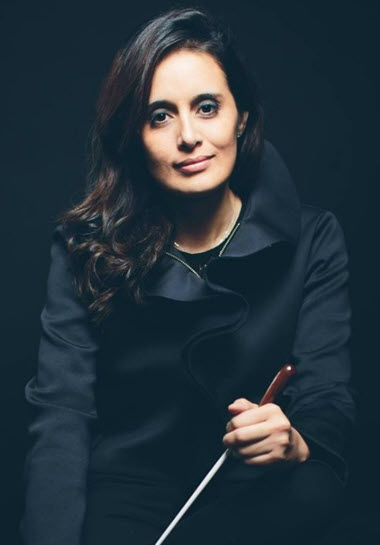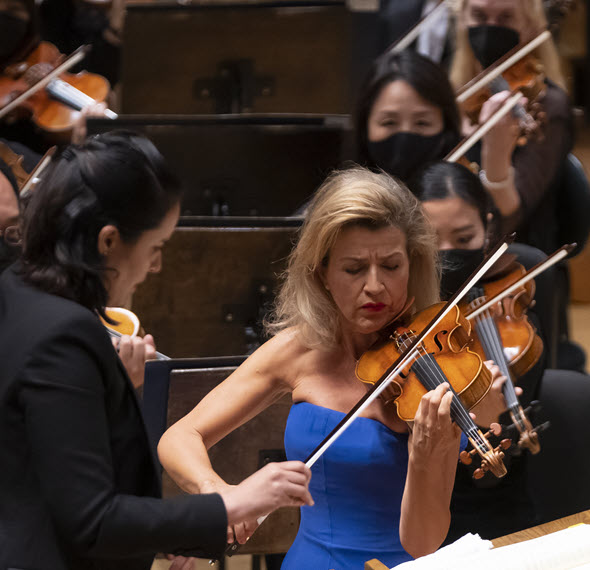With Muti sidelined, young conductor steps up to lead Chicago Symphony in Brahms triumph

Without a rehearsal, Lina González-Granados led the CSO in Brahms’ Symphony No. 1. (Concert photos by Todd Rosenberg)
Review: Chicago Symphony Orchestra conducted by Lina González-Granados; Anne-Sophie Mutter, violin. Repeats June 17 and 18.
By Lawrence B. Johnson
Like the invited guests at the Chicago Symphony Orchestra’s open morning rehearsal on June 16, Lina González-Granados took a seat at Orchestra Hall to watch CSO music director Riccardo Muti lead the troops through Brahms’ Symphony No. 1 in C minor. After a break, the orchestra would be joined onstage by violinist Anne-Sophie Mutter, one of the most celebrated musicians in the world, for a run-through of the Beethoven Violin Concerto, the other work on that evening’s concert program, with Muti on the podium. But that’s not exactly what happened.
Mutter made her appearance, but only after CSO president Jeff Alexander came front and center, a microphone in hand, to inform the audience as well as the assembled musicians that Muti was not feeling well and that, indeed, he had tested positive for Covid. He was done for the day and for the night and very likely for the entire weekend run of three concerts.
Lina González-Granados was no longer in her seat in the audience. She is the CSO’s Georg Solti apprentice conductor, Muti’s immediate back-up in situations like this, and she was now backstage preparing to come out and lead the Beethoven rehearsal with Mutter. What’s more, a good deal more, González-Granados knew she would be conducting the evening concert – including Brahms’ First Symphony, with no opportunity to conduct even one rehearsal of the grand-scaled work. And that’s what she did, with stunning success.
González-Granados’ personal triumph was impressive, but before any accounting of that, it should be made clear the experience and professionalism she brought to a potentially fraught few hours. Besides learning under Muti’s wing over the past two years, the Colombian native has also been mentored by the likes of Bernard Haitink, Marin Alsop and Yannick Nézet-Séguin. She has also conducted major orchestras such as the San Francisco Symphony, the New York Philharmonic and the Philadelphia Orchestra. And she has conducted widely beyond those high spots. I don’t know whether she had conducted Brahms 1 elsewhere, but she doubtless consulted with Muti in an afternoon of intensive preparation.
Still, the pressure must have been formidable. The concert audience showed up expecting Muti, one of the preeminent conductors of our time – only to be informed, again by Alexander, that those shoes would be filled, that stick waved, by this young person with a long hyphenated name whom some might remember from her unexpected appearance in April, when Muti also had tested positive. But on that occasion, there had been time to change the program, from Schumann’s Fourth Symphony and the Britten Piano Concerto with soloist Leif Ove Andsnes. In the end, Andsnes conducted two Mozart concertos from the keyboard and González-Granados led opera overtures by Rossini and Mozart. There was no time for program shuffling this week, on this day.
A famous football coach once said he didn’t want anyone on his team who didn’t throw up before a game. But then you go out and play. Can’t say about the first part of that in González-Granados’ case, but she came to play. I’m sure it helped that the Beethoven concerto, which she had rehearsed with Mutter, was first on the program. In any case, from the start, she had the Brahms well in hand – from the driving timpani beats that set the work in motion.
González-Granados offered a thoughtful Brahms First: fundamentally lyrical, clearly structured, the dramatic apexes specifically set off. The conductor was always on the front edge of the music, always ready with the ensuing inflection. This was an engaged, smart, comprehensive interpretation – a coherent and rewarding take on Brahms that will only deepen as conductor and orchestra return to the First Symphony on June 17 and 18. Certainly, the musicians of the Chicago Symphony were there for González-Granados. They’ve played the Brahms symphonies times beyond number. I couldn’t help thinking of conductor Lorin Maazel in a rehearsal of the Brahms Second Symphony with the CSO during an Asia tour years ago, exclaiming: “My God, what a sound!” That’s how the band delivered for Muti’s apprentice.
Very early on, about halfway into the opening movement’s expansive narrative, I got the feeling that when this was over, the audience was going to explode. And so it did, summoning González-Granados back to the stage for three curtain calls. As the crowd made its way out, I lingered at my seat longer than usual, and spotted González-Granados returning to the stage, still masked, baton still in hand. She headed over to the woodwind section where the players were wiping and putting away their instruments. As she approached them, she extended her arms and made a couple of deep bows, a clear gesture of “You’re awesome, and thank you.” I couldn’t hear any of their replies, but I’m sure the gist was: “Back atcha!”
This was the young conductor’s night, but the undeniable star was the woman in the blue gown with the fiddle. Mutter’s performance was radiant, exquisite, quietly electrifying. Much like Beethoven’s Fourth Piano Concerto, the Violin Concerto possesses a core spirituality that departs from what might be called the composer’s Heroics in E-flat major: the “Eroica” Symphony, the “Emperor” Piano Concerto. Mutter, the consummate virtuoso, summoned an astonishing range of colors and textures, all the while emphasizing a dynamic spectrum built on a true pianissimo. González-Granados and the CSO were attentive and worthy partners. As the audience whooped its appreciation, a beaming Mutter, this great violinist, grasped the conductor’s hand and held it. They were partners, and together they had prevailed.





